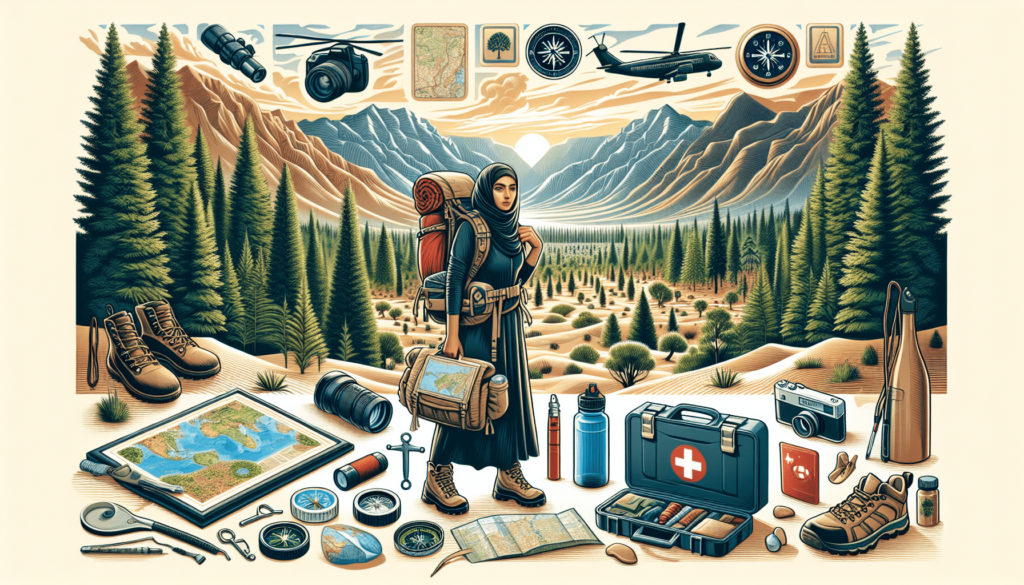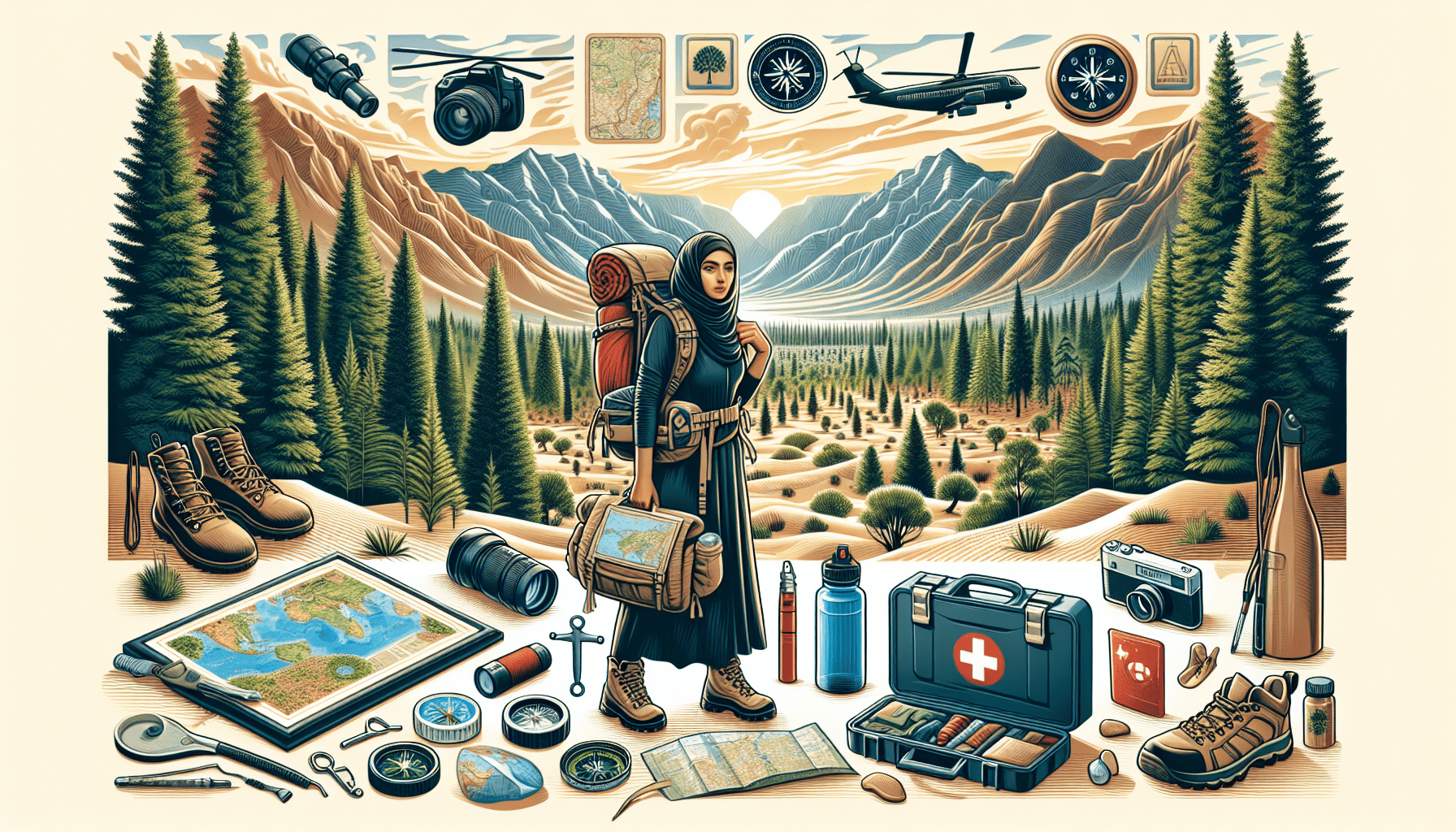How To Stay Safe While Traveling In Remote Areas – Imagine the excitement of exploring remote areas, immersing yourself in untouched landscapes, and discovering hidden gems that few others have experienced. However, amidst the thrill and adventure, it is essential to prioritize your safety.
Whether you are venturing into the depths of dense forests or embarking on a journey through vast deserts, this article will provide you with valuable tips and guidelines on how to stay safe while traveling in remote areas. From planning and preparation to navigation and emergency procedures, equip yourself with the knowledge and tools you need to ensure a secure and enjoyable exploration of the undiscovered.

Research and Planning
Research the region
Before embarking on your journey to a remote area, it is essential to thoroughly research the region you will be visiting. Look for information about the terrain, weather patterns, and any potential dangers or risks that may be present. Understanding the area will prepare you for what to expect and allow you to plan accordingly.
Know the local customs and culture
One of the key aspects of staying safe while traveling in remote areas is respecting and understanding the local customs and culture. Take the time to learn about the traditions, norms, and etiquette of the community you will be visiting. This will help you navigate social interactions more smoothly and avoid unintentional offenses or misunderstandings.
Inform someone about your travel plans
Always make sure to inform someone you trust about your travel plans before heading into a remote area. Share important details such as your itinerary, the duration of your trip, and any contact information they may need in case of an emergency. This ensures that someone is aware of your whereabouts and can reach out for help if necessary.
Health and Vaccinations
Consult a doctor
Before traveling to a remote area, it is strongly recommended to schedule a visit with your doctor. They can provide valuable advice on specific health concerns related to the region you will be exploring, as well as prescribe any necessary medications for your journey. Your doctor can also ensure that you are up to date on your vaccinations to protect against any prevalent diseases or illnesses.
Carry necessary medications
When traveling in remote areas, it is crucial to carry an adequate supply of any medications you regularly take. Additionally, it is wise to pack a basic first aid kit with essential items such as bandages, antiseptic ointment, and pain relievers. This will help you address minor injuries or illnesses that may occur during your journey.
Get necessary vaccinations
Depending on the destination, certain vaccinations may be recommended or required prior to traveling to remote areas. Research the specific immunizations needed and ensure that you receive them well in advance of your trip. These vaccinations protect you from potential diseases and help maintain your overall well-being while exploring unfamiliar territories.
Communication and Navigation
Carry a fully charged phone
One of the most important items to have when traveling in remote areas is a fully charged phone. A phone can be a lifeline in the event of an emergency or when you need to communicate with the outside world. Before leaving, make sure to download offline maps of the area you will be visiting and have emergency contact numbers saved.
Carry a satellite phone or emergency communication device
In some remote regions, cell phone coverage may be limited or nonexistent. In such cases, it is wise to invest in a satellite phone or emergency communication device. These devices operate through satellite signals, providing you with a means of communication in emergencies, even in areas without cell service.
Learn basic navigational skills
When exploring remote areas, it is essential to possess basic navigational skills. Familiarize yourself with using a map and compass, as well as understanding GPS systems. This knowledge will help you stay on track, find your way back if you get lost, and make informed decisions regarding your route.
Emergency Supplies
Pack a first aid kit
Carrying a well-equipped first aid kit is crucial when traveling in remote areas. Stock it with items such as bandages, wound disinfectant, tweezers, and any necessary prescription medications. Additionally, include basic supplies like matches, a flashlight, and a whistle, which can come in handy during emergencies.
Carry extra food and water
In remote areas, access to food and water may be scarce or unreliable. To ensure your well-being, pack extra supplies of non-perishable food and clean drinking water. Choose lightweight and nutrient-dense options that will sustain you in case of unexpected delays or emergencies.
Carry emergency shelter and clothing
Being prepared for unexpected situations includes packing emergency shelter and clothing. Items such as a lightweight tent, a compact sleeping bag or bivvy, and a waterproof jacket can offer protection against harsh weather conditions. Being properly dressed and sheltered can make a significant difference in your safety and comfort.
Traveling in a Group
Travel with others
When venturing into remote areas, it is generally safer to travel with others rather than alone. Joining a group or teaming up with fellow travelers not only enhances your enjoyment but also provides additional security. Having others around can offer support, assist in emergencies, and help share the workload and responsibilities.
Establish a buddy system
Within your travel group, it is essential to establish a buddy system. This means pairing up with another person and regularly checking in with each other throughout the journey. By doing so, you create a system of accountability and can immediately respond if someone goes missing or encounters trouble.
Stick together
In remote areas, it is crucial to stick together as a group. Avoid splitting up, especially in unfamiliar or risky terrain. Staying together ensures that everyone in the group is accounted for, reduces the chances of accidents or getting lost, and provides a sense of safety and security.
Stay Informed
Check weather conditions
Before heading into a remote area, always check the weather conditions. This information allows you to prepare accordingly, pack appropriate gear, and adjust your plans if necessary. Severe weather can pose significant risks, including flooding, avalanches, or extreme temperatures, so staying informed is essential for your safety.
Be aware of local news and alerts
Staying updated on local news and alerts is crucial when traveling in remote regions. Keep an eye on any relevant announcements, such as changes in trail conditions, wildlife encounters, or any safety-related updates. This knowledge helps you make informed decisions and adapt your plans accordingly to ensure your well-being.
Understand the potential risks and challenges
Each remote area comes with its own unique set of risks and challenges. It is essential to understand and acknowledge these potential hazards before setting out on your journey. Research common dangers, such as wildlife encounters, natural disasters, or terrain-specific risks, and prepare accordingly to minimize the likelihood of accidents or injuries.
Maintain a Low Profile
Avoid flashy or expensive items
In remote areas, it is advisable to avoid drawing unnecessary attention to yourself by abstaining from displaying flashy or expensive items. Leave valuable jewelry or conspicuous electronics at home and opt for modest belongings instead. This helps reduce the chances of becoming a target for theft or attracting unwanted attention.
Dress modestly and blend in with locals
Dressing modestly and blending in with the locals can contribute to your safety while traveling in remote areas. Observe and respect the local customs, and aim to dress appropriately for the cultural norms of the community you are visiting. This not only shows respect but also helps you avoid unnecessary attention or potential misunderstandings.
Avoid drawing attention to yourself
To stay safe in remote areas, it is important to avoid drawing unnecessary attention to yourself. This includes refraining from loud or disruptive behavior, respecting the peace and tranquility of the surroundings. By being considerate and maintaining a low profile, you reduce the likelihood of attracting unwanted attention or becoming a target for potential risks.
Trust Your Intuition
Listen to your instincts
When traveling in remote areas, always trust your instincts. If a situation or a person feels unsafe or uncomfortable, listen to your inner voice and respond accordingly. Your intuition serves as an essential tool in protecting your well-being and can guide you away from potentially risky or dangerous circumstances.
Avoid risky situations
To stay safe, it is crucial to avoid knowingly entering risky or dangerous situations. Trust the knowledge you have acquired through research and planning, and do not take unnecessary risks. If a situation poses a significant danger, consider alternative routes or options that prioritize your safety over unnecessary challenges.
Be cautious when interacting with strangers
While traveling, you are likely to encounter strangers along the way. Exercise caution when interacting with individuals you meet in remote areas. While most people are friendly and helpful, it is important to maintain a level of vigilance and not divulge personal or sensitive information to individuals you do not know well.
Stay on Designated Paths
Stick to established trails or paths
When exploring remote areas, it is crucial to stick to established trails or paths whenever possible. These routes have been designated as safe and are monitored by park authorities or local communities. Venturing off the designated paths can lead to getting lost, encountering dangerous wildlife, or facing unforeseen hazards.
Avoid venturing into unknown or dangerous areas
To ensure your safety, it is essential to avoid venturing into unknown or dangerous areas. Keep in mind that remote regions may have certain zones that are off-limits or prohibited due to potential hazards. Respect these guidelines and restrictions, as they are designed to protect you and preserve the integrity of the natural environment.
Observe warning signs and guidelines
Throughout remote areas, you are likely to encounter warning signs and guidelines. Pay close attention to these notices and adhere to their instructions. Whether it is cautionary information about wildlife, dangerous terrain, or environmentally fragile areas, following these guidelines ensures your safety and helps preserve the natural beauty of the region.
Be Prepared for Wildlife Encounters
Research local wildlife
Before traveling to a remote area, take the time to research the local wildlife species that inhabit the region. Understanding the behavior and habitat of wildlife can help you avoid unnecessary encounters or minimize the potential risks associated with them. Knowing what to expect allows you to take precautionary measures and stay safe.
Carry bear spray or deterrents
If you are visiting an area known for bear or wildlife encounters, it is crucial to carry appropriate deterrents such as bear spray. These tools can help deter aggressive animals and provide you with a sense of security in case of an encounter. Familiarize yourself with the proper use of these items to ensure their effectiveness.
Know how to respond in case of an encounter
In the event of a wildlife encounter, it is important to know how to respond appropriately. Different animals require different actions, so being knowledgeable about their behavior and appropriate responses is crucial. Whether it means maintaining a safe distance, making noise to scare off wildlife, or slowly retreating, knowing how to react can prevent potentially dangerous situations.
How To Stay Safe While Traveling In Remote Areas
By following these guidelines and being proactive in your research and preparation, you can significantly increase your safety while traveling in remote areas. Remember that being well-informed, prepared, and attuned to your surroundings are key factors in staying safe and enjoying your adventure to the fullest.
When travelling, enjoyment comes with knowing you are safe whilst you do so, we hope you found some great safety ideas in our article ‘How To Stay Safe While Traveling In Remote Areas‘, and hope you check out some other information packed articles, such as ‘A Foodies Guide To Traditional Russian Cuisine‘.

